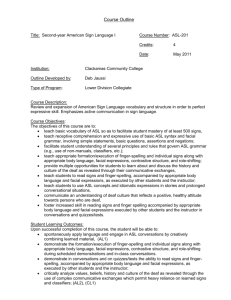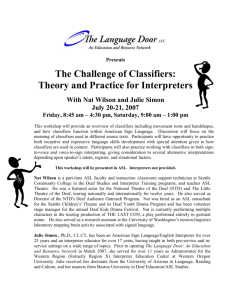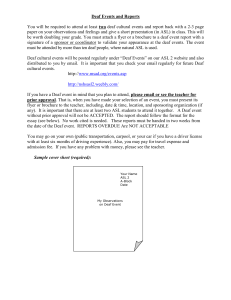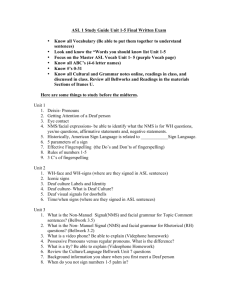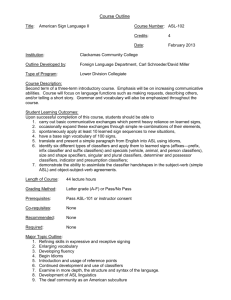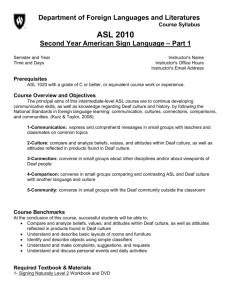Change Course ASL 202 Outline
advertisement
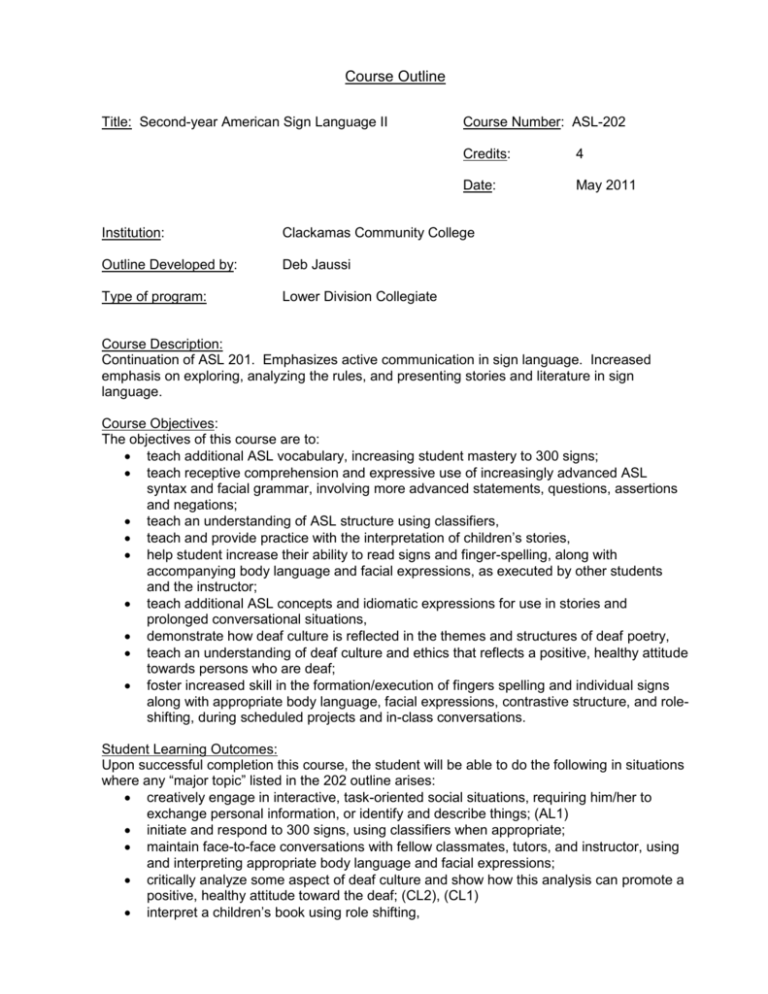
Course Outline Title: Second-year American Sign Language II Course Number: ASL-202 Credits: 4 Date: May 2011 Institution: Clackamas Community College Outline Developed by: Deb Jaussi Type of program: Lower Division Collegiate Course Description: Continuation of ASL 201. Emphasizes active communication in sign language. Increased emphasis on exploring, analyzing the rules, and presenting stories and literature in sign language. Course Objectives: The objectives of this course are to: teach additional ASL vocabulary, increasing student mastery to 300 signs; teach receptive comprehension and expressive use of increasingly advanced ASL syntax and facial grammar, involving more advanced statements, questions, assertions and negations; teach an understanding of ASL structure using classifiers, teach and provide practice with the interpretation of children’s stories, help student increase their ability to read signs and finger-spelling, along with accompanying body language and facial expressions, as executed by other students and the instructor; teach additional ASL concepts and idiomatic expressions for use in stories and prolonged conversational situations, demonstrate how deaf culture is reflected in the themes and structures of deaf poetry, teach an understanding of deaf culture and ethics that reflects a positive, healthy attitude towards persons who are deaf; foster increased skill in the formation/execution of fingers spelling and individual signs along with appropriate body language, facial expressions, contrastive structure, and roleshifting, during scheduled projects and in-class conversations. Student Learning Outcomes: Upon successful completion this course, the student will be able to do the following in situations where any “major topic” listed in the 202 outline arises: creatively engage in interactive, task-oriented social situations, requiring him/her to exchange personal information, or identify and describe things; (AL1) initiate and respond to 300 signs, using classifiers when appropriate; maintain face-to-face conversations with fellow classmates, tutors, and instructor, using and interpreting appropriate body language and facial expressions; critically analyze some aspect of deaf culture and show how this analysis can promote a positive, healthy attitude toward the deaf; (CL2), (CL1) interpret a children’s book using role shifting, discuss and analyze examples of deaf poetry, showing how these examples uniquely reflect deaf culture;(CL1) demonstrate appropriate skill in reading signs and finger spelling accompanied by appropriate body language and facial expressions executed by other students and the instructor in conversations and quizzes/tests, demonstrate appropriate use of ASL concepts and idiomatic expressions in stories and prolonged conversational situations, demonstrate an understanding of deaf culture that reflects a positive, healthy attitude towards persons who are deaf. Length of course: 44 lecture hours per term Grading Method: Letter grade (A-F) or Pass/No Pass Prerequisites: Pass ASL-201 or instructor consent. Major Topic Outline: exchanging personal information describing and Identifying Things classifiers grammar of ASL/translations deaf culture and poetry children’s stories CCC AAOT/ASOT GENERAL EDUCATION OUTCOMES COURSE OUTLINE MAPPING CHART ASL-202 Second-year American Sign Language II Course Title and Number: Mark outcomes addressed by this course: Mark “C” if this course completely addresses the outcome. Students who successfully complete this course are likely to have attained this learning outcome. Mark “S” if this course substantially addresses the outcome. More than one course is required for the outcome to be completely addressed. Students who successfully complete all of the required courses are likely to have attained this learning outcome. Mark “P” if this course partially addresses the outcome. Students will have been exposed to the outcome as part of the class, but the class is not a primary means for attaining the outcome and assessment for general education purposes may not be necessary. As a result of completing the AAOT /ASOT general education requirements, students will be able to: WR: Writing Outcomes 1. Read actively, think critically, and write purposefully and capably for academic and, in some cases, professional audiences. 2. Locate, evaluate, and ethically utilize information to communicate effectively. 3. Demonstrate appropriate reasoning in response to complex issues. SP: Speech/Oral Communication Outcomes 1. Engage in ethical communication processes that accomplish goals. 2. Respond to the needs of diverse audiences and contexts. 3. Build and manage relationships. MA: Mathematics Outcomes 1. Use appropriate mathematics to solve problems. 2. Recognize which mathematical concepts are applicable to a scenario, apply appropriate mathematics and technology in its analysis, and then accurately interpret, validate, and communicate the results. AL: Arts and Letters Outcomes i 1. Interpret and engage in the Arts & Letters, making use of the creative process to enrich the quality of life. 2. Critically analyze values and ethics within a range of human experience and expression to engage more fully in local and global issues. SS: Social Science Outcomes 1. Apply analytical skills to social phenomena in order to understand human behavior. 2. Apply knowledge and experience to foster personal growth and better appreciate the diverse social world in which we live. SC: Science or Computer Science Outcomes 1. Gather, comprehend, and communicate scientific and technical information in order to explore ideas, models, and solutions and generate further questions. 2. Apply scientific and technical modes of inquiry, individually, and collaboratively, to critically evaluate existing or alternative explanations, solve problems, and make evidence-based decisions in an ethical manner. 3. Assess the strengths and weaknesses of scientific studies and critically examine the influence of scientific and technical knowledge on human society and the environment. CL: Cultural Literacy Outcomeii 1. Identify and analyze complex practices, values, and beliefs and the culturally and historically defined meanings of difference. IL: Information Literacy Outcomesiii 1. Formulate a problem statement. 2. Determine the nature and extent of the information needed to address the problem. 3. Access relevant information effectively and efficiently. 4. Evaluate information and its course critically. 5. Understand many of the economic, legal, and social issues surrounding the use of information. i ii iii S S C “Arts and Letters” refers to works of art, whether written, crafted, designed, or performed and documents of historical or cultural significance. Must be embedded in a course that meets the outcomes for Arts and Letters, Social Science, or Science/Computer Science. Must be embedded in the general education required Writing courses Revised 2010-2011 to reflect Statewide AAOT outcomes
